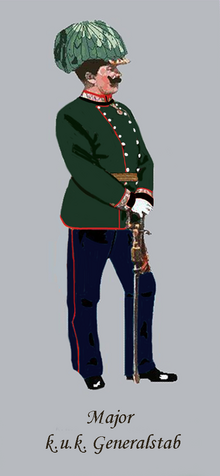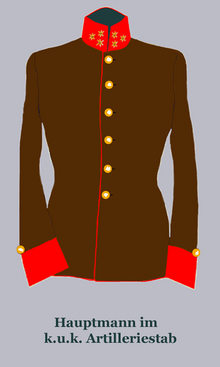kuk staff
The kuk staff of the Austro-Hungarian armed forces was divided into three organizations:
- The general staff
- The artillery staff
- The staff of genius
The general staff
The task of the General Staff was to make all preparations in the event of an impending war, to lead them and to monitor the implementation. The higher command had to be supported by the General Staff in all strategic, tactical and administrative arrangements.
At the head of the General Staff was a senior general with the title "Chief of the General Staff for the entire armed power". The General Staff was formally part of the Austro-Hungarian War Ministry , but the Chief of General Staff had the right to speak directly to the Emperor and, like the War Minister himself, was obliged to implement the orders of the Supreme Warlord .
At the beginning of the First World War , as the 84-year-old Emperor Franz Joseph I did not want to lead the command himself, the Army High Command was set up, to which the General Staff belonged. The chief of staff was now directly subordinate to the army commander (Archduke Friedrich in the first half of the war, mostly Emperor Karl I himself in the second half of the war ). As agreed with Franz Joseph I, Archduke Friedrich mostly gave the Chief of Staff a free hand. Charles I also intervened directly in the events and therefore soon changed the chief of staff.
The general staff consisted of:
- the General Staff Corps ( general staff officers from the captain upwards)
- assigned officers of the force
The General Staff Corps was formed by officers who had demonstrated the necessary scientific qualifications and had been tried out in practical General Staff service. For this test, the officer was first assigned to the general staff.
Depending on such an “allocation”, there was evidence of very good service to date, of character and physical suitability, as well as completion of the war school with at least the grade of “good”.
First lieutenants , who were assigned to the General Staff after completing the Austro-Hungarian War School and who had met the requirements for one and a half to three years of membership, were promoted to captains ( Rittmeisters ) at the request of the Chief of the General Staff, with simultaneous transfer to the troops . After at least two years of deployment of the troops, only those captains were hired into the General Staff Corps who had performed the troop service with very good qualifications.
The officers of the General Staff found the following uses in peacetime:
- In the offices of the General Staff
- The management office for all personnel and economic matters
- The office for operational and special general staff work
- The land description office for keeping records of foreign armies
- The railway office
- The telegraph office
- With the military authorities and higher command
- A first lieutenant as general staff officer at each brigade command
- A staff officer of the General Staff Corps as head of a General Staff department in each troop division and each military territorial command. He carried the title of "Chief of Staff" (of the respective formation)
- Assigned to the troops
- In special use
- as school commanders and / or teachers in military schools
- as military representatives and / or military attachés abroad
Adjustment of the general staff officers
The gauntlet with green plume as well as the field cap corresponded to those of the general with a German uniform. The dark green tunic had a black velvet collar and cuffs, scarlet passepoils, and two rows of smooth yellow buttons. The dark green blouse (until 1908, then pike gray) and the blue-gray coat were equipped with black velvet, passepoiled parolis in scarlet red . The pantaloons were made of blue-gray cloth with scarlet passepoils. The armband was tied around the waist. Armament like infantry officers.
The officers assigned to the General Staff continued to wear the uniform of their regular troops. The armband was worn over the right shoulder to the left hip for identification.
The artillery staff
The artillery staff represented an independent group within the kuk staff system until 1896. The artillery staff of the kuk armed forces included in particular those officers who were assigned to the higher command and authorities of the army due to their experience or training as specialists in artillery. They came from the artillery force or the technical artillery. In peacetime the artillery staff officers, who were assigned to the Austro-Hungarian War Ministry and the higher command, were responsible for the uniformity of the artillery training and had to supervise the work in the artillery production facilities.
In contrast to the general and genius staff, which remained as a kind of "closed corps" within the Austro-Hungarian armed forces until 1918, there was no longer an independent artillery staff after 1896. Since the promotion regulations introduced in that year did not recognize the term artillery staff, it was, as it were, tacitly dissolved. In its place, the new regulation created the designation "officer in special use of artillery". After 1896, the term artillery staff lived on in the troops as an unofficial synonym for "the entirety of the Austro-Hungarian officers in special use of the artillery ", especially since the members of this group of people continued their service as before 1896 as experts in artillery for the higher command and authorities of the army.
The group of military personnel in special use of the artillery consisted of officers from the captain upwards, analogous to the regulations in the staff of genius (see there). The staff were supplemented by officers who had completed the two-year "higher artillery course" at the Technical Military Academy with at least a grade of "good". Before a final appointment as an officer in special use of the artillery , a further use of the troops took place as a suitability test of the candidate.
The officers in special use of the artillery , like the officers of the general staff and the staff of geniuses, received promotional privileges.
Adjustment of the artillery staff officers
Adjustment and armament corresponded to the artillery officers. Only the buttons were smooth and yellow.
The staff of genius
The genius was responsible for the management of the war engineering service; he participated in the attack and the defense of fixed places (see engineering team ). At the head of the staff was a general who carried the title "General Engineer Inspector". The staff consisted of officers from the captain upwards and other assigned officers.
The addition of staff was carried out by officers who had to have completed the higher genius course with at least a grade of “good”. Before the final transfer to the baton of genius, a command was given to test the aspirant.
A staff officer or senior captain was assigned to the military department of each military territorial command to work on the tasks in his area of expertise.
Staff officers also served in the Technical Military Committee, the military training institutions and in the engineering and fortress construction departments.
Adjustment of the staff officers
The headgear was the cap with black cock feathers, similar to that of the military doctors, and a black field cap. The tunic was made of light blue cloth with two rows of smooth yellow buttons and cherry-red velvet leveling. The field blouse was also made of light blue cloth until 1908 (then in pike gray) and equipped with parolis in cherry red velvet. The same was true of the coat. The pantaloons in blue-gray with cherry-red velvet passepoils. Armament and armband like infantry officers.
literature
- Julius Lohmeyer (Ed.): The military picture book. The armies of Europe . 2nd improved and updated edition. Carl Flemming Verlag, Glogau 1887 (Unchanged reprint: Weltbild-Verlag, Augsburg 1998, ISBN 3-8289-0300-2 ).
- Allmayer-Beck , Lessing : The K. (below) K. Army. 1848-1914 . Bertelsmann, Munich et al. 1974, ISBN 3-570-07287-8 .
- The Austro-Hungarian Army 1895 . A series of images by Oskar Brüch , commented by Günter Dirrheimer. Leopold Stocker Verlag, Graz et al. 1997, ISBN 3-7020-0783-0 ( Writings of the Heeresgeschichtliches Museum 10).
- Rest, Ortner, Ilmig: The emperor's rock in the 1st World War . Verlag Militaria, Vienna 2002, ISBN 3-9501642-0-0 .
Footnotes
- ↑ In contrast to the German Army (Army of the German Empire from 1871–1918), the addition to the rank "in the General Staff" (i. G.) was not common for General Staff officers.
- ↑ in reality, however, antharzite-colored
- ↑ Hubert Zeinar, History of the Austrian General Staff, Böhlau Verlag, Vienna 2006, ISBN 978-3-205-77415-0 , pp. 421-422.








